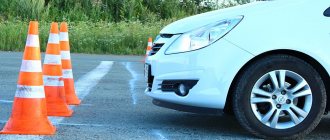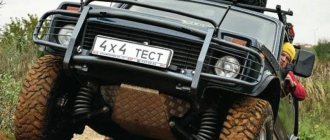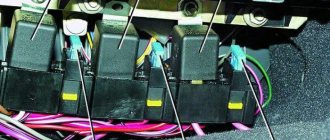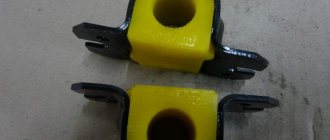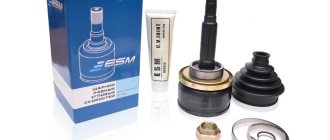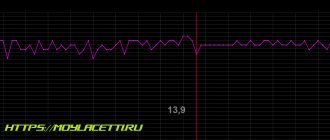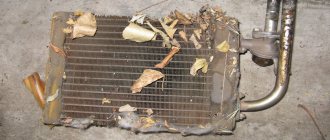Having received a driver's license and bought a car, it is worth driving for some time on not very busy roads and practicing parking in places where this action can be done as simply as possible. This must be done not only because you still have too little driving experience, but also because you need to get used to your new iron friend and feel the dimensions of the car. At this stage, many people wonder how to feel the dimensions of the car if I am a beginner. It is the sense of size that allows you to perform any maneuvers without violating your own and others’ safety.
Recommendations and tips: how to feel the dimensions of a car.
Dimensions
The concept of dimensions usually refers to the height, length and width of the car. But the machine is not only in a static position; it also has dynamic dimensions. Those who have carefully studied in a driving school know that there are six main indicators:
- A straight line that continues the wheels – left and right.
- Continuation line of the front bumper.
- Rear bumper.
- Front axle.
- Rear axle.
These parameters are completely different for different brands and not only beginners, but also quite experienced drivers need to get used to them. You can feel them well only after some time has passed - this is the experience of traveling in this particular car. Only after feeling his car, the driver can easily fit into a dense traffic flow or park in a very small and inconvenient space. The same feeling allows you to avoid bumps on the road or move on rough terrain. It’s quite easy to spot a novice driving; many of them try to crane their necks during the trip and try to look at the road in front of the bumper. Such drivers can often see various minor damage to the bumper, front and rear, or headlights. All this is most often the result of unsuccessful parking. You can try to avoid this, because even minor repairs often cost a very tidy sum.
How to learn to feel a car
A few simple exercises will help you learn how to feel the dimensions of a car. Novice drivers should practice spatial orientation skills on a closed race track. It is for this purpose that instructors separate small areas with flags and force students to drive into a conditional box. We suggest watching a video about how to learn to sense dimensions, and then complete several lessons.
Lesson 1. Visualization
Mentally draw the position of your car relative to the walls of the box, get out of the vehicle and compare the picture presented with the real one. As a rule, it seems to beginners that the edges of the car are much closer to the walls of a conventional garage than they actually are.
Lesson 2. Beacons
Install an antenna at the extreme point of the hood; it will help you understand where the car body ends. At any time you can stop the car, get out of the car and see how close the obstacle is. After this, it will become clear how to do it correctly in a car, how to evaluate the distance and your own dimensions.
Lesson 3. Marking lines
If you are a beginner, to get a feel for the car, mark six lines on the asphalt with chalk or spray paint that:
The intersection points of the wheels with the front dashboard can be marked with colored paper or tape on the windshield. The marks will give an idea of the expected trajectory of movement. Thus, you will learn to determine the place on the road along which the car’s wheels will pass. Over time, the tags will no longer be needed; a chain of reactions will be developed in the brain.
Similarly, you can mark the intersection lines of the front and rear bumpers, front and rear wheels. The markings will make it easier to determine and feel the size and trajectory of the car.
Lesson 4. Getting hit by wheels
Place a small piece of cardboard on the road and deliberately try to run over it with each wheel in turn. This exercise will help you develop your sense of wheel line. Practice not only moving forward, but also reversing.
Lesson 5. Snake
Place barriers on the roadway and try to go around the obstacles without hitting them. Lighthouses can be marked with flags, cones, or ordinary plastic bottles.
Try to drive as close to the beacons as possible. Start with simple exercises, and over time make the tasks more difficult for yourself: place the flags closer together and try to guide the car closely between obstacles; "eight" and "snake".
The main advice on how to get used to the dimensions of the car is to practice as much as possible. You can also watch the video, which will help you get acquainted more clearly https://www.youtube.com/watch?v=l4EiBC8tgP8. Ask an experienced driver or instructor for additional training with you on the site.
Skills are acquired through driving. You will learn to intuitively sense the correct distance to obstacles with high accuracy. With experience, you will understand how to navigate the mirrors in the car, how to feel the car.
Source: mosavtoshkola.org
Developing a sense of size
For a good driver, the feeling of the car occurs automatically, as if subconsciously, and the goal of any beginner is to achieve exactly this level. To the question of how a beginner can get used to the size, the answer is clear - you need to not be lazy and do some self-preparation. Experienced motorists and driving instructors talk about several groups of possible complexes:
- Completing a complex of individual, or self-guided, training using improvised or stationary means.
- Individual preparatory work on the car.
- Completing training using assistive electronic devices.
Individual car preparation
The adequacy of driving will depend on how comfortable, and most importantly, how correctly the driver sits behind the wheel. Proper seating reduces unnecessary driver movements and speeds up the decision-making process. This is achieved due to the fact that the driver has the correct position of his arms and legs, and in addition, sufficient visibility, without unnecessary bending and peeking. To achieve the optimal fit, the driver needs to make a special adjustment. Adjusting the driver's seat and steering wheel
- Sit in the driver's seat and adjust it just for you. Ideally, you need to fully depress the clutch and move the seat forward or backward so that it is comfortable and there is no desire to stretch. The backrest is adjustable so that when using your legs you do not have to move your entire body.
- Do the same with the steering wheel - your palm should fit between the rim of the steering wheel and your knees, and at the same time the second hand should be extended above the steering wheel and touch its top point with your wrist.
How to learn to feel the dimensions of a car? Exercises and tips for a beginner
It is impossible to imagine the modern world without all this variety of cars. If you look at the road from the top floor of your house, it looks like chaos, which seems impossible to overcome. It turns out that you can only adapt to it and learn to exist in it.
However, the roads seem like this, rather, to people who do not often have the opportunity to stay in this “world” and even survive. Drivers, especially those with some driving experience, feel like fish in water on the road. Of course, to become the same as them and begin to feel the same, you need to go a long way. In order to become an experienced driver and not be afraid of the road, know all the rules of the road, be able to maneuver and brake , you must first of all learn to “communicate” with your car. Of course, in a figurative sense, namely, to begin to feel its dimensions.
Exercises to bring the feeling of a car to automaticity
There is a fairly wide variety of training options for inexperienced drivers, which allow you to quickly feel the dimensions of the car. We want to introduce you to the most effective ones.
Beacons
This is the simplest, but no less useful way to feel the dimensions. For this method we will need the following items that are absolutely safe for the car:
- Cones of any bright color.
- Plastic bottles filled with sand. For better visibility, you can stick bright flags into the bottles.
- Sacks or cardboard boxes filled with something very soft.
- Old tires.
The next step will be to install these beacons. Now you can start working directly.
- The driver must stop his car so that his front bumper, first the central part, and then the sides, touches the installed beacon. It’s important to touch, and not knock over or miss – this happens about the tenth or fifteenth time.
- Then you need to practice the same exercise with the rear bumper. These exercises should be brought to automaticity.
- After completing the first two stages, you need to move on. We mark with beacons the contours of two cars with a distance of 9 - 10 meters. Next, we begin to practice the parallel parking method, which is considered quite difficult.
- We put tall sticks in bottles with sand that will imitate gates and begin to work out the passage. First, the distance between the bottles should be approximately equal to the width of your car + 1 meter. Then we gradually narrow the distance, reducing it by 10 cm each time. The exercise will be considered completed if you can drive the car into a gap that exceeds the dimensions of the vehicle by only 10 cm.
How to feel the dimensions of a car?
Don't be lazy to spend time on practical exercises. And you can practice in the following way: we take light boxes and build from them something similar to a gate, after which we try to drive through them. You need to devote several hours to this exercise, and if you cope with this task easily, we complicate it, that is, we reduce the distance between the boxes and increase the speed.
Approximately the same principle can be used - using boxes we designate the space into which we will need to move.
You can learn to feel the dimensions of your car in other ways. We draw a line on the asphalt, and then try to drive up close to it, but at the same time you should not touch it with your wheels.
And if you see that you cannot complete this exercise, then you can return to the task with boxes again. Also remember, this exercise will need to be performed until you learn to correctly determine the distance between your vehicle and such a stop line. This task is intended not only for the front wheels, but also for the rear ones.
In addition to these, there are other equally effective exercises. We take chalk and draw lines from the front wheels of the car 7 - 8 meters in front of them. At the same time, try to keep them as parallel to each other as possible. Next, we sit behind the wheel of a car, look for some stationary object that is constantly in front of your eyes (a protrusion on the dashboard can be suitable as such an object), and connect this object with the line that we drew from the right wheel, then along In the same diagram we mark the position of the left wheel. Thanks to this exercise, we will be able to feel the dimensions of our car. We drive away from these lines a little back, then drive your wheels onto them again.
If you combine all the above exercises, then I think you will get used to the dimensions of your car very quickly.
See also:
If you are an inexperienced motorist or have purchased a new car with large or, on the contrary, small dimensions, you need to get used to them and learn to feel them, because the ability to maneuver and safety on the road largely depends on this.
In order to feel your iron horse, driving schools have entire specialized courses, but this art can be learned without spending money.
